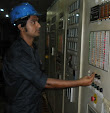NTC Thermistors
A conventional metal-oxide thermistor has a NTC; that is, its resistance decreases with the increase in temperature. The NTC thermistor’s resistance, as of any resistor, is determined by it physical dimensions and the material resistivity. The relationship between the resistance and temperature is highly nonlinear (Fig. below).
Whenever high accuracy is required or the operating range is wide, the thermistor characteristics should not be taken directly from a manufacturer’s data sheet. Typical tolerances of the nominal resistance (at 25◦C) for mass-produced thermistors are rather wide: ±20% is quite common. Unless it was adjusted at the factory to a better tolerance, to reach a high accuracy each such thermistor needs to be individually calibrated over the operating temperature range. Manufacturers can trim a thermistor by grinding its body to a required dimension that directly controls the nominal value of resistance at a set temperature. This, however, increases cost. An alternative approach for an end user is to individually calibrate the thermistors. Calibration means that a thermistor has to be subjected to a precisely known temperature (a stirred water bath is often employed3) and its resistance is measured. This is repeated at several temperatures if a multipoint calibration is needed. Naturally, a thermistor calibration is as good as the accuracy of the reference thermometer used during the calibration. To measure the resistance of a thermistor, it is attached to a measurement circuit that passes through it electric current. Depending on the required accuracy and the production cost restrictions, a thermistor calibration can be based on the use of one of several known approximations (models) of its temperature response. When a thermistor is used as an absolute-temperature sensor, we assume that all of its characteristics are based on the so-called “zero-power resistance”, meaning that the electric current passing through a thermistor does not result in any temperature in-crease (self-heating) which may affect accuracy of measurement.
Fabrication of NTC Thermistors
Generally, the NTC thermistors can be classified into three major groups depending on the method by which they are fabricated.
- The first group consists of bead-type thermistors. The beads may be bare or coated with glass epoxy (Fig.below), or encap-sulated into a metal jacket. All of these beads have platinum alloy lead wires which are sintered into the ceramic body. When fabricated, a small portion of a mixed metal oxide with a suitable binder is placed onto parallel leadwires, which are under slight tension. After the mixture has been allowed to dry or has been partly sintered, the strand of beads is removed from the supporting fixture and placed into a tubular fur-nace for the final sintering. The metal oxide shrinks onto the lead wires during this firing process and forms an intimate electrical bond. Then, the beads are individually cut from the strand and are given an appropriate coating.
 |
| Glass coated bead type thermistor |
- Another type of thermistor is a chip thermistor with surface contacts for the lead wires. Usually, the chips are fabricated by a tape-casting process, with subsequent screenprinting, spraying, painting, or vacuum metallization of the surface electrodes. The chips are either bladed or cut into the desired geometry. If desirable, the chips can be ground to meet the required tolerances.
 |
| Chip thermistor |
- The third type of thermistor is fabricated by the depositing semiconductive ma-terials on a suitable substrate, such as glass, alumina, silicon, and so forth. These thermistors are preferable for integrated sensors and for a special class of thermal infrared detectors.
 |
| Semiconductor materials fabricated conductor |
Among the metallized surface contact thermistors, flakes and uncoated chips are the least stable. A moderate stability may be obtained by epoxy coating. The bead type with lead wires sintered into the ceramic body permits operation at higher tem-peratures, up to 550◦C. The metallized surface contact thermistors usually are rated up to 150◦C. Whenever a fast response time is required, bead thermistors are prefer-able; however, they are more expensive than the chip type. Also, the bead thermistors are more difficult to trim to a desired nominal value. Trimming is usually performed by mechanical grinding of a thermistor at a selected temperature (usually 25◦C) to change its geometry and thus to bring its resistance to a specified value.
While using the NTC thermistors, one must not overlook possible sources of error. One of them is aging, which for the low-quality sensors may be as large as +1%/year. A good environmental protection and preaging is a powerful method of sensor characteristic stabilizing. During preaging, the thermistor is maintained at +300◦C for at least 700 h. For better protection, it may be further encapsulated in a stainless-steel jacket and potted with epoxy.









